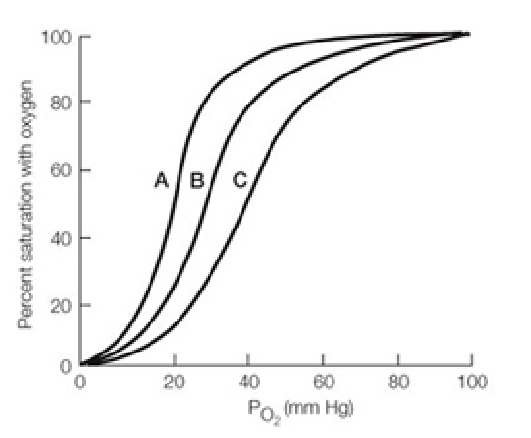In the below graph, curve _______ is most likely the oxygen-binding curve for normal adult human hemoglobin, curve _______ is most likely that of llama hemoglobin (from a llama population that has lived in the mountains of Peru for thousands of years), and curve _______ is most likely that of myoglobin.

A. B, C, A
B. C, B, A
C. A, B, C
D. B, A, C
E. A, C, B
Clarify Question
What is the key concept addressed by the question?
What type of thinking is required?
Gather Content
What do you already know about myoglobin and hemoglobin? What other information is related to the question?
Choose Answer
Given what you now know, what information is most likely to produce the correct answer?
Reflect on Process
Did your problem-solving process lead you to the correct answer? If not, where did the process break down or lead you astray? How can you revise your approach to produce a more desirable result?
B. C, B, A
Clarify Question
What is the key concept addressed by the question?
· This question is asking you to interpret oxygen dissociation curves.
What type of thinking is required?
· Analyze level:
o This question is asking you to identify key factors that qualify something as hemoglobin or myoglobin.
Gather Content
What do you already know about myoglobin and hemoglobin? What other information is related to the question?
· As altitude increases in mountainous regions, available oxygen levels decrease.
· Myoglobin is found in muscle cells.
· The affinity of myoglobin for oxygen is much higher than that of hemoglobin.
· When hemoglobin has been depleted of oxygen, in the same circumstance myoglobin will still have oxygen.
Choose Answer
Given what you now know, what information is most likely to produce the correct answer?
· This graph shows oxygen saturation increasing on the Y axis, and available oxygen available increasing on the X axis.
· When comparing the three curves, example “A” has the highest oxygen saturation (60%) at PO2 of 20mmHg. This is characteristic of myoglobin.
· Example “B” has a moderate amount of oxygen saturation (approximately 25%)at PO2 of 20mmHg. This is characteristic of hemoglobin, and since this is a moderate value for these three curves, it would represent the llamas in a mountainous environment. Organisms such as the llamas in this example have less oxygen available, so they may have increased RBC counts to deliver more oxygen to the tissues.
· Example “C” has the lowest oxygen saturation (approximately 10%) at PO2 of 20mmHg. This is characteristic of hemoglobin in an organism does not live not at an extreme altitude.
Reflect on Process
Did your problem-solving process lead you to the correct answer? If not, where did the process break down or lead you astray? How can you revise your approach to produce a more desirable result?
· Analyze level:
o Answering this question correctly depended not only on distinguishing between hemoglobin and myoglobin, but also on your ability to break down, or analyze, oxygen dissociation curves. If you got an incorrect answer, did you remember that components of hemoglobin include a lower affinity for oxygen than myoglobin, or that atmospheric pressure can affect oxygen saturation? Did you have trouble breaking down the differences between myoglobin and hemoglobin to determine the correct answer?
You might also like to view...
Allergic reactions are triggered by the production of ____ antibodies instead of ____ antibodies at the first exposure to
the allergen. a. IgA; IgD b. IgA; IgE c. IgE; IgM d. IgE; IgG e. IgG; IgE
Cytochrome c is a small protein that is found in present-day organisms. Comparison of the structure of cytochrome c from different organisms to infer evolutionary relationships would be part of the science involving
A) fossil evidence. B) developmental biology. C) comparative biochemistry. D) migration patterns. E) comparative anatomy.
The use of organisms to develop useful products is called:a
bioengineering. b. in vitro gene technology. c. biotechnology. d. recombinant DNA technology. e. genetic engineering.
Cilia are found in certain
A) Protozoa B) Fungi C) Algae D) Bacteria E) All of the above